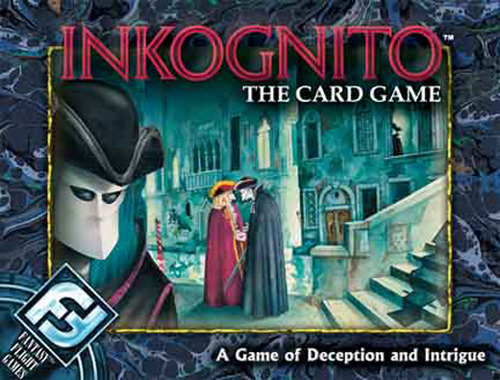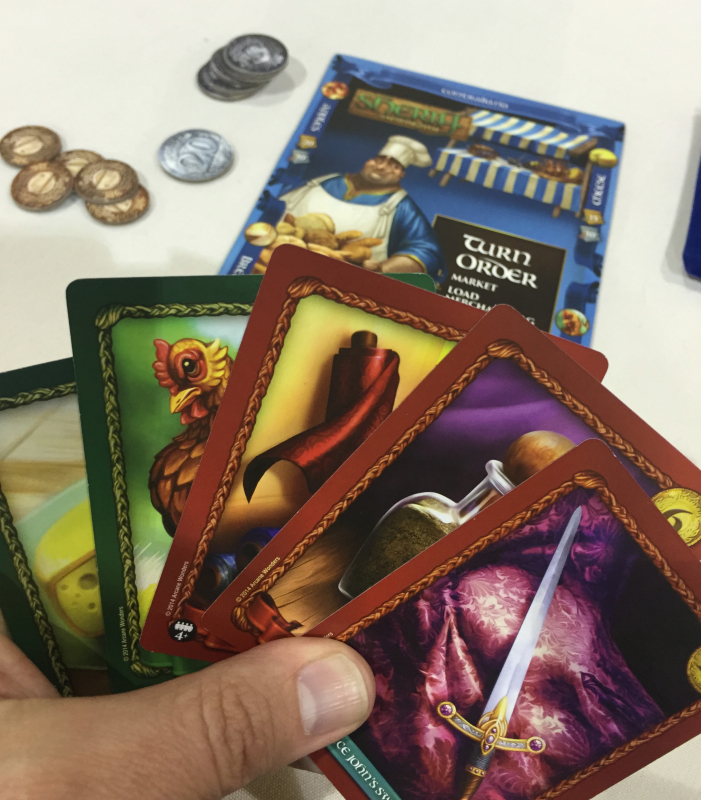SaltCon: Board games Galore – My Day #1 (part 1)
After a week away on a business trip, I was sure looking forward to a couple days of non-stop board game playing at SaltCon this past weekend.
And I’m happy to report that it was just as fun as I had anticipated!
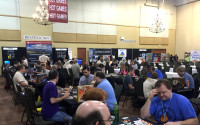
If you like playing board games, then SaltCon is for you. It’s non-stop open gaming for 3 days.
With a game library of over 800 games, there’s never a shortage of something to play.
And if you’re not familiar with how to play a particular game, there’s always someone close by happily willing to teach you.
Yes, the games I played were a lot of fun. But most of the fun is found in the “who”, not the “what”.
And the people that play games at SaltCon are a fantastic assortment of friendly, fun players.
As much as I was excited to play some new games, I was even more excited to meet up with people I’ve met at previous SaltCons. It was so great to see them and play games with them again this past weekend – as well as meet even more fun folks.
Overall I played 20 different board games and card games – 19 of which were new to me!
Since that’s a lot to write about, I’m breaking it up into a series of posts that will include mini-reviews of the games I played.
Here’s Day 1, Part 1.
Day #1
Every year, SaltCon runs for 3 days. This year it was Thursday, Friday, and Saturday. But I was only able to go on Friday and Saturday. So Friday was my Day #1.
I made the hour drive to the Davis Conference Center Friday morning and arrived at 10am – ready to dive into the fun.
Trading Games
The first thing I did was to take many of our games to the Math Trade and Swap Meet tables.
Most readers may not have any clue what a “math trade” is so I’ll briefly explain it. A game math trade is a cool way to trade some of your games for other games. It’s hard to find a 1 to 1 match for game trades – meaning I’ll trade you my game A for your game B – because both parties have to want each other’s game B and A. So what a math trade does is use a computer algorithm to match up trades.
Weeks before the conference I (and many other people) post which games I’d like to trade away. Then I look over the list of games people are trading and indicate which of those games I’d like to have in return – indicating which games I’d be willing to trade for them. For example, I may not be willing to trade a big box game for a small card game. But I would be willing to trade one of my small card games for one in return.
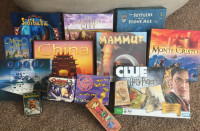
Then the computer makes all the connections such as: Person 1 want game J. So he trades game A to Person 2 (who wants game A), who in turn trades game B to Person 3, who in turn trades his game C to Person 4, …. all the way through to Person 10 trading game J to Person 1. So in the end everyone gets games they want.
I had 11 games accepted in the math trade, so I took those 11 games to the trade table and put the sticky notes on them of who they would go to. Then in turn I’d go back later to find the games left out for me that I’d get in the trade – board games I was really looking forward to.
The next tables were the Swap Meet tables where anyone could set out games they wanted to sell. I put sticky notes on the games with my name, number, and the price I’d sell them for and then I was off to play. I took about 15 games I was willing to sell.
Playing Games
As soon as I was done putting the games out, I met up with Doug (a person I had met at SaltCon 2014 and really enjoyed playing games with) and we sat down with a few others to play one of the “Hot Games”: Colt Express
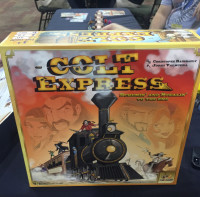
Colt Express
About 8 game tables at SaltCon are dedicated to the Hot Games. These are board games that a lot of people are interested in playing/discovering. Typically they’re recently released games that people are clamoring to play.
Colt Express was a great game to start with!
Colt Express is a fun family game about train robbers vying to grab the most loot. As you can tell from the photo, it has awesome components! It’s no wonder it was on one of the Hot Games table. You can’t help but stop and check this game out.
Like one of my favorite board games, RoboRally, Colt Express is a game of pre-programmed movement. There are two phase in each round. The first phase is where everyone chooses which action cards they want to play and in what order. Then in the second phase all those actions take place.
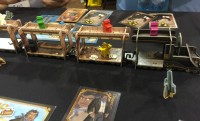
The actions include moving from train car to car, moving up or down from the roof, picking up some loot, punching, shooting, or moving the sheriff.
Every round the player cards are played slightly different. Sometimes they need to be played (programmed) face-up and other times face-down. So sometimes you’ll know what the other players are trying to do and sometimes you won’t. You may have great plans to move forward a couple cars and pick up a gem. But then another player moves the sheriff into that same car (knocking you up to the roof) or punches you (causing you to drop some of your loot).
I immediately loved it!
Deus
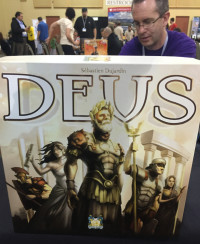
We then moved on to another game on the Hot Games tables: Deus
Deus is a game about civilization-building and conquering barbarian villages. At the outset, the variable board with all it’s terrain type colors looks similar to Settlers of Catan. Even some of the playing piece shapes seem very Catanish. However, it plays very differently than Catan.
In Deus players work to develop their own civilizations across the boards. Each player starts the game with five building cards, and on a turn a player either uses one of these cards to construct a building or discard one or more cards to make an offering to a god. Cards come in six colors which each focus on a different aspect of a civilization.
When you construct a building, you place the associated playing piece on the board then place the card in your personal tableau. In doing so you also activate the power of all of those similar color cards already in your tableau. When you make an offering, you discard cards, then receive the help of a god associated with one of the cards that you discarded.
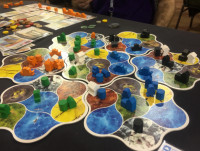
The game ends either when all the barbarian villages on the game board have been surrounded and attacked or when all the temples have been constructed. Whoever has the most points wins.
I won’t write too much more about Deus today – nor will I in the future – simply because it fell flat for me. Yes, it kept me engaged during the game, but I was almost exclusively engaged in reading the variety of cards in my hand and figuring which I could afford to play. Yes, we were playing on a shared game board vying for locations, but I really wasn’t caught up in what others were doing. It felt very heads-down without much interaction with the other players.
After that, Doug and I moved on to a game that brought back some player interaction: Machi Koro
Machi Koro
Machi Koro is a simple card & dice game where players benefit when they, as well as the other players, roll the dice.
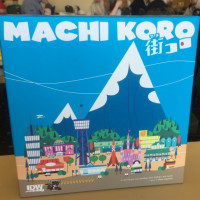
The theme in Machi Koro is that players are completing buildings and landmarks to develop the city. Build the best city before the others and you win.
The buildings are represented by named cards with a number at the top and an effect on them. Depending on the color of the card, different effects will take place as well. For example, every player begins with a blue Wheat Field and a green Bakery. The number on the Wheat Field is 1 and the numbers on the Bakery are 2-3.
Each of these cards generate 1 coin when activated. If a 1 is rolled by any player, then the blue Wheat Field generates income of 1 coin for anyone that has a wheat field. The green cards are only activated by the player rolling the die/dice. So if a player rolls a 2 or 3, then only that player will get 1 coin.
After a player rolls and collects their coins, they can buy another building or landmark.
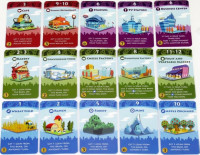
Each player starts with just rolling 1 die, but can later roll 2 dice on their turn once they’ve purchased/built the Train Station.
There are also red and purple building cards that require other players to pay the person who rolled the die/dice.
Play continues with players rolling dice, getting income, and building bigger (more costly) buildings and landmarks until someone purchases their 4th and final landmark (grey cards). The player that purchases their 4th landmark first is the winner.
I can tell why Machi Koro is becoming a popular family game. It’s a light and straightforward game that’s very approachable. There isn’t much downtime waiting for others to take their turns either since everyone can generate income from blue cards no matter who rolls the dice.
It’s always fun to get money when it’s another player’s turn. 🙂
Machi Koro wasn’t on the Hot Games tables because it’s been out for a little while. But it was a game I was interested in playing heading into SaltCon, so Doug had brought his copy to teach me the game. We were joined by 2 other players (father (Alex) and son) and the son ran away with the win. It ended sooner than I had anticipated, but Machi Koro will definitely be a game that I’ll play again.
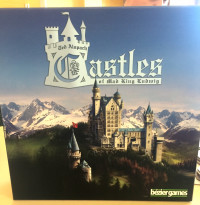
Castles of Mad King Ludwig
The next game we played was also a game I had high on my “want to play” list and it was also on a Hot Games table: Castles of Mad King Ludwig
Castles of Mad King Ludwig is about building crazy castles one room at a time. In the game, King Ludwig II of Bavaria has commissioned the players to build the biggest, best castle ever. Each player acts as a building contractor who is adding rooms to the castle he’s building while also selling his services to other players.
Each player starts with a simple foyer with 4 doorways which additional rooms or hallways can connect to. One player takes on the role of the Master Builder, and that player sets prices for a set of rooms that can be purchased by the other players, with him getting to pick from the leftovers after the other players have paid him for their rooms. When a room is added to a castle, the player who built it gains castle points based on the size and type of room constructed, as well as bonus points based on the location of the room. When a room is completed, with all entranceways leading to other rooms in the castle, the player receives one of seven special rewards.
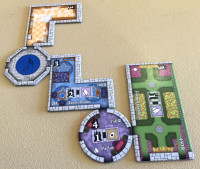
I really liked Castles of Mad King Ludwig.
There’s a lot of variety in the game and it’s really fun adding on many different rooms to the castle. It seemed everyone took pictures of their completed castles whether they won or not.
In addition to the randomness of which rooms become available for purchase, every game begins with selecting 3 random points conditions. I really like the random selection because it makes every game different and like a puzzle.
For example in our game, the 3 categories for awarding extra points were to the player with the most square footage of food rooms, most square footage of corridors, and most square footage of sleeping rooms. I didn’t count the number of options for those extra points, but the stack seemed to be around 20 different possibilities.
In addition to that, players get cards during the game that award them extra points at the end of the games based on secret objectives (like building certain shape or size rooms).
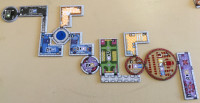
Not only do players need to figure what rooms they want to build in order to score points during the game as well as extra points at then end, but they also need to figure out how much they’re willing to pay for the rooms. Everyone takes turns being the master builder and setting the price of the rooms that round. All payment for the rooms go to the master builder (except for the master builder who pays the bank).
So as master builder you get to strategize on which rooms the others players will want to build and set the price accordingly to either make a bunch of money or set yourself up for getting the room you most want.
It was a lot of fun and like Colt Express, Castles of King Ludwig was quickly added to my game wish list.
Alien Frontiers
After those first 4 games, I introduced Doug to Alien Frontiers. Doug had purchased a Kickstarter version of Alien Frontiers, but hadn’t played it yet. His Kickstarter version came with rocket dice – so that was a nice additional treat to play with.
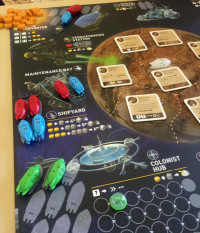
His copy of the game board was actually double-sided – with one side being made for standard dice and the other side printed for use with the rocket dice.
While the rocket dice were fun to play with, we found that they were more prone to changing their orientation when bumped. For example, after rolling the dice our tendency is to gather them together to put similar dice results next to each other (looking for double, etc.). But attempting to grab the dice, they’d sometimes roll over to another number. Not a big problem when considering that rocket dice to represent spaceships adds to the space theme very well.
And that brings me to the mid-point of Day #1.
More mini-reviews of new games I played at SaltCon to come over the next few days…
> Subscribe via Email to make sure you don’t miss the upcoming mini-reviews.

